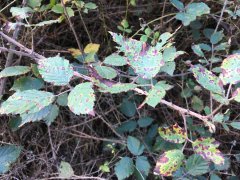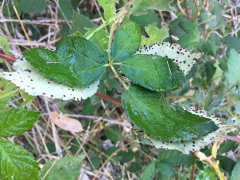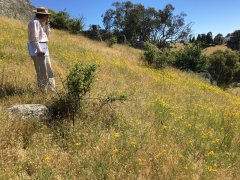THE PROBLEM
Two of the principal weeds affecting grazing country on the granite hills and slopes around Hovells Creek are Blackberry and St John’s Wort. Both weeds are long established in the area and if not controlled are capable of taking over large areas.
While St John’s Wort can be controlled to a degree by grazing at the right time of year by merino sheep, this is very difficult to achieve in large paddocks in hilly rocky country because of the tendency of sheep to preferentially graze the higher areas of each paddock. Similarly, blackberry can be controlled by grazing with goats, but again this is not practical in large hilly paddocks with ordinary sheep fencing that can allow goats to escape.
So the current control method in the area for both blackberry and St John’s Wort is spraying with herbicide. However, this is expensive, very difficult to achieve in hilly country and the experience is that repeat spraying is required in later years.'
ADOPTION OF BIOLOGICAL CONTROL APPROACH
Over the years there have been repeated attempts to use biological control agents to control Blackberry and St John’s Wort. However, this is an approach which has not been actively pursued in the Hovells Creek area in recent years.
In 2015, the HCLG Executive became aware of the recent release of new and different strains of blackberry leaf rust in areas of Victoria and areas adjacent to the Snowy Mountains. Similarly, there was talk of areas of St John’s Wort near Wyangala Dam (on the northern border of the Hovells Creek area) being killed by combined attacks by mites and beetles released there some years previously. It was therefore decided to investigate these possibilities and John Baker, Deputy-Chair of HCLG, was made project manager for the investigation and related work.
- BLACKBERRY LEAF RUST
In mid-March 2015 HCLG organised the release of blackberry leaf rust on five properties in the HCLG area at a cost of $1,000, which was paid from HCLG’s own funds. The objective was to create a number of ‘nurseries’ where the blackberry leaf rust could establish itself and which could then be used as sources for multiple releases of blackberry leaf rust from October 2015 onwards. The intention was to seek other funding to support these future releases and to run workshops to familiarise members on how to release the rust etc.
The leaf rust was sourced from Barry Sampson, an ex-CSIRO staffer, whose Deniliquin-based Weedbiocontrol business was able to supply a relatively new strain of blackberry leaf rust which, while it does not initially kill the plants significantly weakens them, including preventing fruiting and limiting their further spread. HCLG was told by Barry that it had been used in the Adaminaby and Canberra area with significant success, but has not previously been released in the central west NSW area.
The leaf rust was released by Barry Sampson together with the project manager at Old Graham in mid-March 2015, where he made two releases of leaf rust onto two geographically separate and distinct patches of blackberries on Old Graham. Present on the occasion were several other landowners who took other sets of leaf materials for release on their own properties, having seen how Barry fastened the rust-infected leaves onto those of healthy blackberry bushes.
In mid-2016 HCLG received $3,500 funding from SELLS, as part of a wider Community Industry and Landscapes Fund project, to support work on weed control, including biological weed control. The intention was to use the funds to help promote the spread of the blackberry leaf rust and to also support work on the release of the mites and beetles that affect St John’s Wort.
However, inspections in the autumn of 2016 of the five sites where the blackberry leaf rust had been released showed no evidence of the rust. Barry Sampson advised that two other release locations at Crookwell and Bigga had similarly reported no active rust and he wondered whether the rust-infected plant material supplied to us in March 2015 had been off the plant at Adaminaby for too long, such that the rust was no longer potent. Barry agreed to supply replacement rust-infected plant materials, but by the time these discussions and investigations had been completed it was too late in the season to supply replacement plant materials in 2016.
In 2017 Barry Sampson had moved to the north coast of NSW and so on his advice the project manager contacted rangers in the ACT Environment, Planning and Sustainability Directorate, whom Barry Sampson had previously supplied with the same strain of blackberry rust. Arrangements were then made for the project manager to collect rust-infected plant materials in March/April 2017 from the Curries Road release site off the Brindabella Road fairly high in the Brindabella Mountains. These were put in a cooler box with some ice in the bottom to keep the leaves fresh and the same day they were driven to Hovells Creek where they were released at four sites off the Frogmore Road, including two on Old Graham. Unfortunately, as of autumn 2018 there was no sign that the rust had established itself at any of the release sites.
Extensive reading of the literature on blackberry leaf rust, and discussions with Jason Corcoran of the Southern Slopes Noxious Plant Authority, suggests that climatically the Hovells Creek area may be beyond the range of the blackberry leaf rust – including of the newer strains, other than in warm wet summers. Unfortunately the area has had hot dry summers recently, so the prospects do not look promising for blackberry rust.
- ST JOHN’S WORT MITES AND BEETLES
In the summer of 2014 the project manager, on the advice of Jason Corcoran of the Southern Slopes Noxious Plant Authority, arranged for half a wool bale of mite and beetle-infected St John’s Wort to be collected from a property near to Wyangala Dam where the St John’s Wort had been seriously attacked by mites and beetles. The infected plant materials was then distributed at a number of points on Old Graham and on neighbouring Kondon.
Subsequently in the spring of 2015 several slopes on Old Graham, which had previously had a dense cover of St John’s Wort, and where the infected plant materials was released, were seen to be largely clear of St John’s Wort. Careful examination showed that 80 per cent of plant stems (it is a perennial) were dead and rotten, while 20 per cent had very small shoots, but no significant growth.
In mid-2016 HCLG received $3,500 funding from SELLS, as part of a wider Community Industry and Landscapes Fund project, to support work on weed control, including biological weed control. The intention was to use the funds to help promote the spread of the blackberry leaf rust and to also support work on the release of the mites and beetles that affect St John’s Wort.
In 2016 the slopes remained effectively clear of wort, although there were occasional small plants with only limited flowers and hence few seeds. The infection of the mite and beetles had spread over the brow of the hill and in the summer of 2016 could be seen moving down an adjoining hill. Again we spread infected plant material to other areas of wort.
After a very wet winter and spring in 2016, 2017 was a disappointing year as there was moderate re-infestation by wort of the slope cleared in 2015 and the mites and beetles no longer seemed to be actively spreading and attacking other areas of wort.
In spring 2017 beetles were in evidence across much of Old Graham and Kondon, at a light density of one beetle to every few clumps of wort. Unfortunately after a period of wet and cold weather no beetles were in evidence and none were seen during the summer of 2017/18. In the meantime wort had recolonised previously clear areas and we now seem to be back where we started in 2015, although in the meantime wort has also spread to previously unaffected areas.
Discussions with a Landcare group in Queanbeyan and reading of various studies of the use of biological control on St John’s Wort suggest that what occurred at Old Graham is very typical. One can have good years when mite and beetles really decimate the wort, followed by other years when the wort seems to be barely affected by mite and beetles. As with blackberry rust, climate and variations in the weather appear to be a key determinant. Unfortunately there seems to be no published research which describes the sort of climate and weather which supports the activity of the mite and beetles and what weather is inimical to their growth and spread.
Results to date suggest that it is therefore premature to try to encourage HCLG members to actively spread wort and beetles as a worthwhile control measure of St John’s Wort. This prompted HCLG to seek approval to reallocate the SELLS CILF funding to other purposes, as it was not thought it could usefully be used to run a workshop to promote the spread of blackberry and wort control measures.
JRB 5/6/18
Blackberry
Rust-infected blackberries at the Curries Rd release site in the Brindabella Mountains, ACT
https://hovellscreeklandcare.org.au/images/blackberry/Blackberry-Leaf-at-Brindabella.jpg
Rust-infected blackberry leaves from Curries Rd release site stapled onto blackberry leaves at a new release site at Hovells Creek
https://hovellscreeklandcare.org.au/images/blackberry/Blackberry-Leaf-Stapled.jpg
Inspecting St John’s Wort on hillside at Old Graham to check for mite and beetle damage
https://hovellscreeklandcare.org.au/images/blackberry/St-Johns-Wort.jpg




